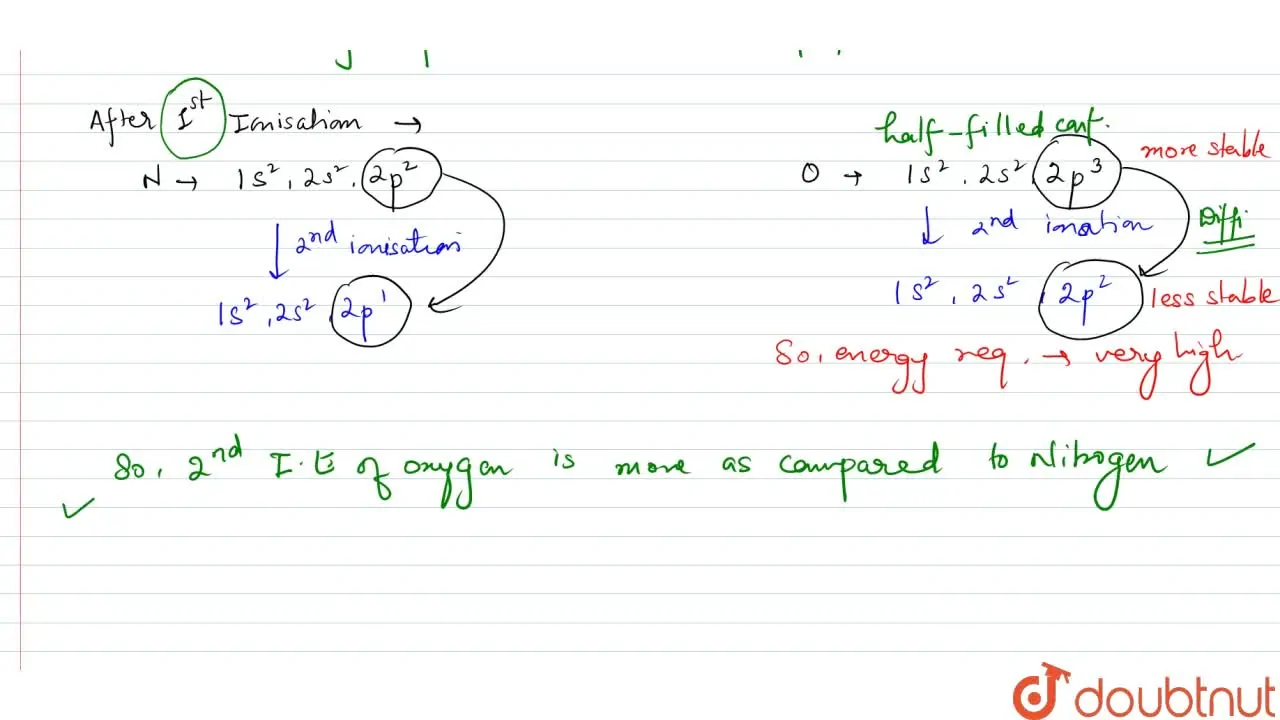The first ionisation enthalpy of nitrogen (Z=7) is greater than that of oxygen (Z =8) but the reverse is true for the second ionisation enthalpy. Explain why.
Let us first consider the electric configuration of N (Z=7) and O(Z=8)
N(Z=7)=1s2,2s2,2p3

Nitrogen has three electrons in p-suborbit (half Filled p-subshell).
These valence electrons are arranged as three singly occupied orbitals.
This is very stable arrangement thatit requires very high energy to remove an electron from its outer most shell.
O(Z=8)=1s2,2s2,2p4

Oxygen has four electrons in p-subshell.
These valence electrons are arranged as one doubly occupied and two singly occupied orbitals.
Due to doubly occupied orbitals, it is easier to remove a n electron from its outermost shell.
Thus, the first ionisation enthalpy of nitrogen is greater than that of oxygen.
While this is reversed for the second ionisation enthalpy.
Nitrogen having only two occupied electrons easily loose an electron while oxygen having three electrons arranged as three singly occupied orbitals become more stable and require very high energy to remove an electron from its outermost shell.
Related Playlists
- BOOK - ICSECHAPTER - SAMPLE QUESTION PAPER -1EXERCISE - Match the following:1videos
SAMPLE QUESTION PAPER -1
- BOOK - ICSECHAPTER - SAMPLE QUESTION PAPEREXERCISE - Question69videos
SAMPLE QUESTION PAPER
- BOOK - ICSECHAPTER - SAMPLE QUESTION PAPER -2EXERCISE - Questions & Answers10videos
SAMPLE QUESTION PAPER -2
Similar Questions
Why the first ionisation energy of carbon atom is greater than that of boron atom whereas, the reverse is true for the second ionisation energy.
View SolutionGive reason for the following :
a. The first ioisation eathalpy of carbon carbon is greater than that foboron, whereas the reverse is true fore the second ionisation enthalpy .
b. Solid carbon dioxie is known as dry ice .
c. Why does not silicon form an analogue fo graphite ?View SolutionWhy is the ionisation enthalpy of hydrogen higher than that of sodium ?
View SolutionThe ionisation energy of nitrogen is more than that of oxygen because
View SolutionThe first ionisation energy of magnesium is greater
than that of sodium, whereas the reverse is true for
second ionisation energy. Explain.View SolutionThe first ionisation energy of first atom is greater than that of second atom, whereas reverse order is true for their second ionisation energy. Which set of elements is in accordance to above statement?
View SolutionWhy first ionisation enthalpy of Cr is lower than that of Zn?
View SolutionWhy is the ionisation enthalpy of magnesium higher than that of potassium ?
View SolutionWhat is the order of the second ionisation enthalpy of K,Ca and Ba?
View SolutionThe first ionisation enthalpy of the elements C,N,P,Si are in the order of
View Solution


